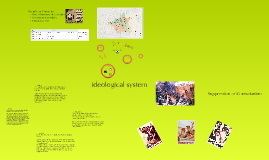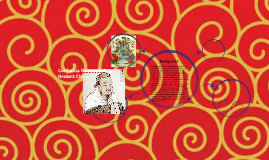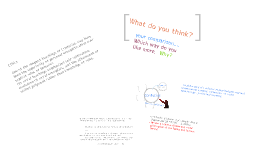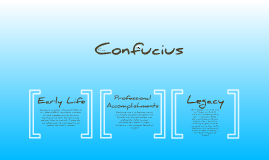Confucius
Transcript: Confucius' Analects Where: Eastern China When:551-479 B.C. Authors: Confucius' disciples Language: Chinese Disciples of Confucius Three thousand the disciples Seventy-two worthies Confucius' ten QI dismissed like socrates threat minister and nobel defamed him CHEN WEI not wanting involvement in politics deliver his duty to his student being teacher LU Cofucianism involves the beliefs of: Tao and Teh Yin and Yang Tao=Nature "The Way" Comings and goings, and well as beginnings and endings, are ever present in life. Every "being" has its own "Way" or nature, which it follows. Teh=the ability to follow one's own nature reverence for ancient rituals, ancestry, and authority: Book 1 #11 "The Master said, "Observe what a man has in mind to do when his father is living, and then observe what he does when his gather is dead. If, for 3 years, he makes no changes to his father's ways, he can be said to be a good son." (Lawall 823) leading by virtue: Book 2 #19 "...Confucius answered, "Raise the straight and set them over the crooked and the common people will look up to you. Raise the crooked and set them over the straight and the common people will not look up to you." (Lawall 823) performing to the best of one's ability in all circumstances-following one's nature, or Tao: Book 6 #12 "Jan Chiu said, 'It is not that I am not pleased with your way, but rather that my strength gives out.' The Master said, ' A man whose strength guves out collapses along the course. In your case you set the limits beforehand.' " (Lawall 824) wisdom: Book 6 #22 "Fan Ch'ih asked about wisdom. The Master said, 'To work for the things the common people have a right to and to keep one's distance from the gods and spirits while showing them reverence can be called wisdom...' " (Lawall 824-825) Distinction The Analects' are unique from other world literature we have read thus far in class "Wisdom comes in fractions and fragments; the burden of full understanding is placed on the reader" (Lawall 821) 3.9 "The Master said to Tzu-kung, 'Who is the better man, you or Hui?' 'How dare I compare myself with Hui? When he is told one thing, he understands. When I am told one thing I understand only two...' " (Lawall 824) ideological system Political -If a country wants to flourish the first thing is not to make laws for the public but to enhance the king's morality "guide them by edicts, keep them in line with punishments and the common people will stay out of trouble but will have no sense of shame. Guide the by virtue, keep them in line with the rites, and they will, besides having a sense of shame, reform themselves" Economic -When we face an advantage/profit, the first thing people have to consider is our morality The Master said, "Riches and honors are what men desire. If they cannot be obtained in the proper way, they should not be held. Poverty and meanness are what men dislike. If they cannot be avoided in the proper way, they should not be avoided. "If a superior man abandon virtue, how can he fulfill the requirements of that name? "The superior man does not, even for the space of a single meal, act contrary to virtue. In moments of haste, he cleaves to it. In seasons of danger, he cleaves to it." Aesthetic To use literature and art as a political method for changing society. chi tsze-ch'ang said, "in a superior man it is only the substantial qualities which are wanted;-why should we seek for ornamental accomplishments?" tsze-kung said, "alas! your words, sir, show you to be a superior man, but four horses cannot overtake the tongue. ornament is as substance; substance is as ornament. the hide of a tiger or a leopard stripped of its hair, is like the hide of a dog or a goat stripped of its hair." Education -Relate all the things they learned together -people can be affected by others, -If we want to live in a better world we have to change ourselves first. The Master said, "When I walk along with two others, they may serve me as my teachers. I will select their good qualities and follow them, their bad qualities and avoid them." Suppression of Confucianism Analects did not preach Mandate of Heaven. "Tsze-kung said, 'The Master's personal displays of his principles and ordinary descriptions of them may be heard. His discourses about man's nature, and the way of Heaven, cannot be heard.' Analects 5.13. "The Master said, "To work for the things the common people have a right to and to keep one's distancefrom the gods and spirits while showing them reverence can be called wisdom. ' " (Lawall 824-825) Rulers should be virtuous. "The Master said, 'The rule of virtue can be compared to the Pole Star which commands the homage of the multitude of stars without leaving its place.' " 2.1 (Lawall 823) Otherwise, the people have right to rebel, as granted by Heaven. " '...when there is no trust, the commom people will have nothing to stand on.' " Works cited: Bahm, Archie J., and Confucius. The Heart of Confucius; Interpretations of Genuine Living and Great

















